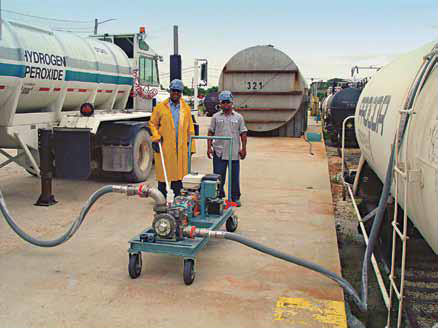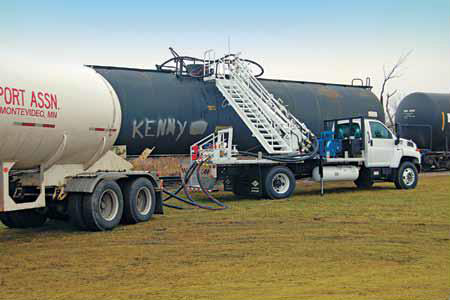12/17/2011
As the popularity of transloading continues to grow, operators should consider sliding vane pump and gas compressor technology for low maintenance costs and high energy efficiency.
Introduction
Transloading is the practice of transferring products between modes of transport, whether from refinery to terminal, terminal to supplier, supplier to storage facility or supplier to end-user. The products that are typically transloaded can run the gamut from liquid chemicals and petroleum products, to animal fats and vegetable oils, to raw and semi-finished commodities such as grains and dairy products. The modes of transport include marine, pipeline, rail, air and truck. Goods, whether raw or finished, rarely travel directly from their source to the end-user. The focus of this article will be the transloading of products or raw materials from railcar to truck. Transloading allows shippers and their customers to enjoy many of the cost benefits of rail transportation without having a rail siding at their door, which can be an expensive proposition, and for many companies, a physical impossibility. In most instances, a transload facility operator, third-party logistics company or transportation broker facilitates the transloading for both the shipper and the consignee. These companies coordinate truck and rail connections and frequently offer inventory management and facilitate storage and delivery. The main objective of transloading is to place the goods as close as economically possible to the point of final processing, packaging and consumption . Therefore, transloading can occur at any location at which a truck can pull up to another truck or a train. In a typical transaction, a bulk shipment moves by rail to a transload facility where it is offloaded with specialized pumping equipment that has the necessary operational characteristics to handle the specific product or material. The bulk product can then be scheduled for delivery in smaller quantities to the consignee for further processing or delivery directly to an end-user. Some advantages of transloading are:- Quick response to replenish inventories
- Transportation costs kept to a minimum
- Accelerated turnover and reduce inventory costs
The Challenge
Transloading has grown rapidly in recent years, so much so that it now has its own trade association. The Transloading Distribution Association —TDA (www.transload.org)—West Linn, Ore., represents the interests of the transloading industry as it relates to business and political leaders, while positioning transloading as the preferred method for efficient distribution of product in the 21st century. Currently, the TDA has more than 200 members throughout the U.S., Canada and Mexico. As mentioned, the main challenge for shippers is moving their products in the safest manner while also minimizing the risk of costly and environmentally damaging product spills. Recently, however, economics have played an increasingly important role in a shipper's decision to move product via a transloading operation. These economic pressures have come to bear in the form of driver and equipment shortages, record high fuel costs found in long haul trucking and increased demand for shipping capacity. Operators at this chemical distribution/storage terminal facility transload hydrogen peroxide from a railcare to a transport via a sliding vane pump.
Operators at this chemical distribution/storage terminal facility transload hydrogen peroxide from a railcare to a transport via a sliding vane pump. This transloading application features compressors transferring LPG from railcars to transports.
This transloading application features compressors transferring LPG from railcars to transports.The Solution
Fortunately for the vast array of shippers who are implementing transloading operations, an easy solution is available for their product-transfer needs. It is sliding vane pumps and reciprocating-gas compressors. Sliding vane pumps and compressors used in transloading operations must be highly energy efficient and eliminate many of the maintenance concerns that are inherent in these pumps and compressors. The sliding vane technology makes these pumps ideal for transloading applications. These pumps are self-priming, designed to run dry for short periods and their high suction makes them ideal for line-stripping. They are available in cast iron, ductile iron and stainless steel models with special elastomers that make them compatible with the handling of many products. For self-loading trucks, the pumps come with port sizes to 4 inches and have maximum working pressures up to 175 psi (12.1 bar). They can reach speeds of 1,200 rpm with both PTO and hydraulic drive capabilities. For transloading applications that involve stationary and portable onsite pumps, by manifolding the railcars, the flow rates are limited to the receiving capacity of the system. Some sliding vane pumps are also available in sealless designs for applications that require zero shaft leakage. The vanes in a sliding vane pump move freely into or out of slots in the pump rotor. When the pump driver turns the rotor, centrifugal force, rods and/or pressurized fluid causes the vanes to move outward in their slots and bear against the inner bore of the pump casing, forming pumping chambers. As the rotor revolves, fluid flows into the area between the vanes when they pass the suction port. This fluid is transported around the pump casing until the discharge port is reached. At this point, the fluid is squeezed out into the discharge piping. This simple pumping principle, which has been an industry standard for more than a century, allows sliding vane pumps to handle numerous products safely and efficiently. Among these are:- Clean, non-corrosive industrial liquids and petroleum products
- Liquids ranging in viscosity from thin solvents to heavy oils
- Hazardous fluids
- Biofuels
- Non-lubricating solvents to highly viscous liquids or abrasive slurries
- Corrosive or caustic fluids
- Inks, paints and adhesives

